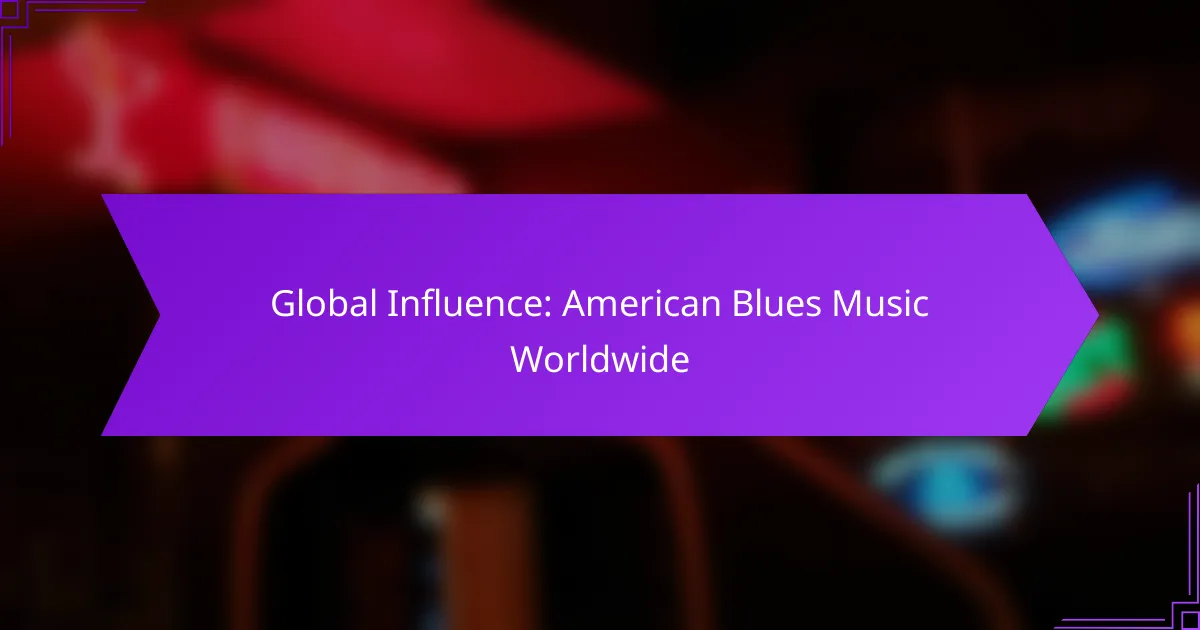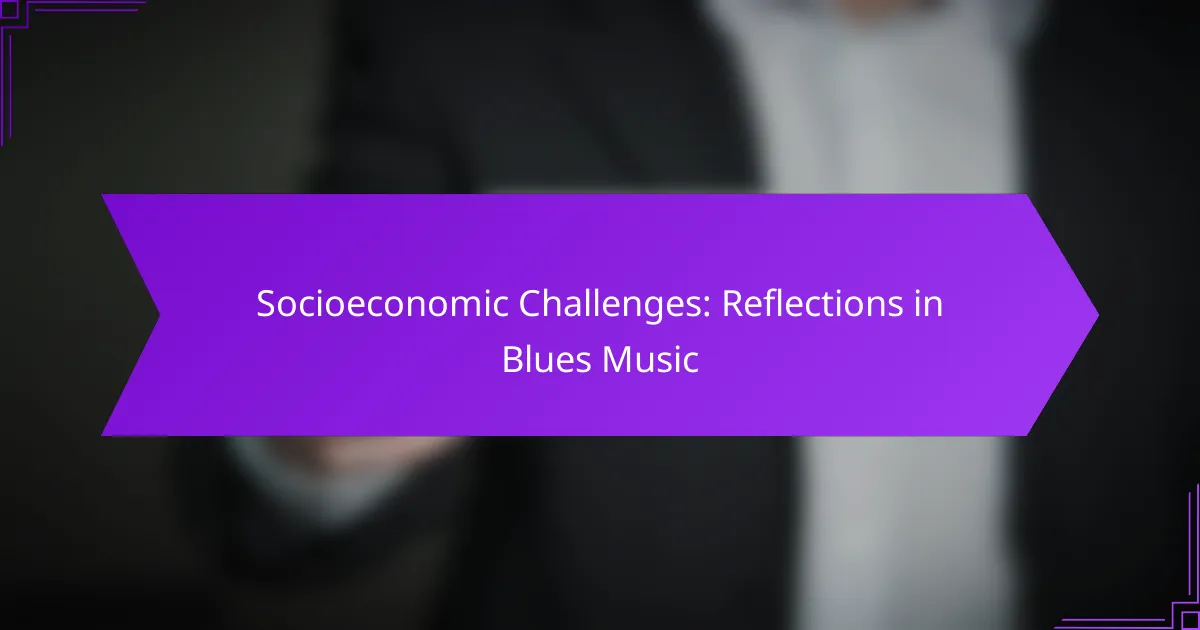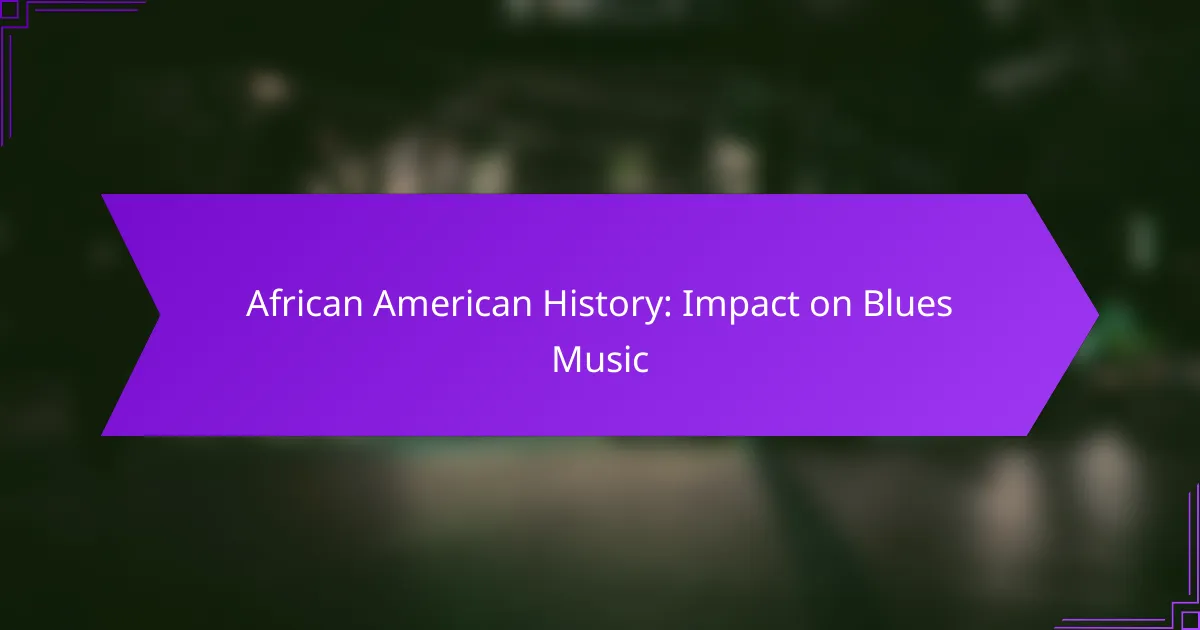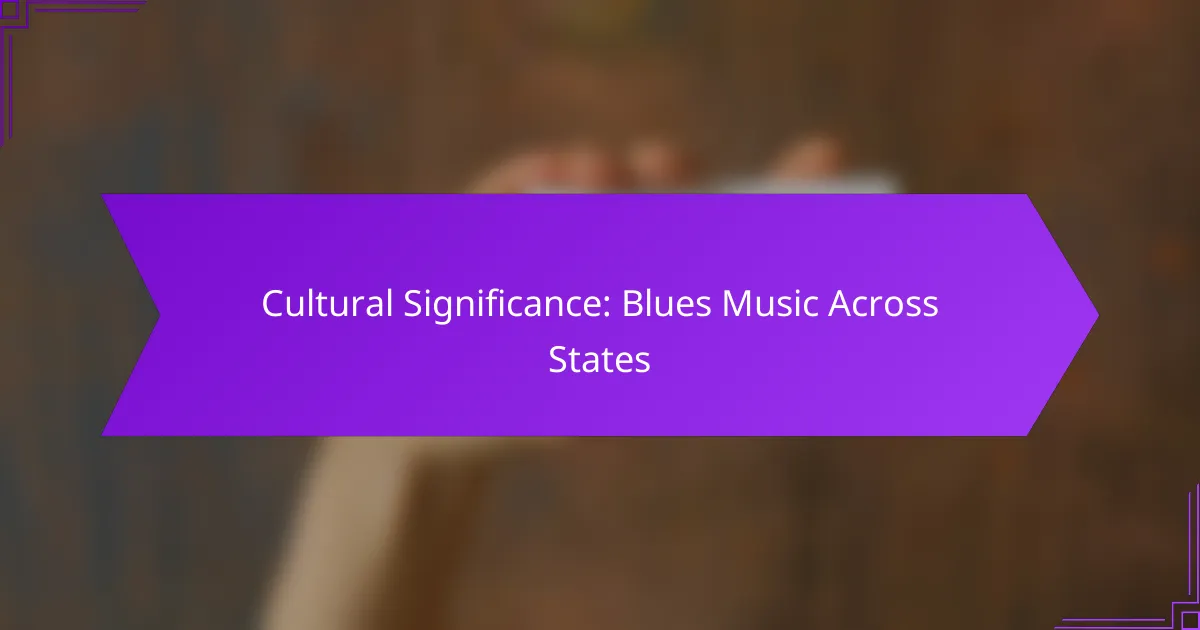American blues music has profoundly influenced global music by introducing distinctive rhythms and emotional depth that resonate across various genres. Artists like B.B. King and Muddy Waters have left a lasting impact, inspiring musicians worldwide and integrating blues elements into rock, jazz, and pop. This rich legacy is celebrated globally through festivals and clubs, where blues enthusiasts gather to appreciate both local and international talent.

How has American blues music influenced global music genres?
American blues music has significantly shaped various global music genres by introducing unique rhythms, structures, and emotional depth. Its influence can be seen in rock, jazz, world music, pop, and hip-hop, where the core elements of blues have been adapted and integrated into diverse musical styles worldwide.
Impact on rock music
The impact of American blues on rock music is profound, as many rock musicians have drawn inspiration from blues artists. Iconic bands like The Rolling Stones and Led Zeppelin have incorporated blues riffs and structures into their music, creating a sound that resonates with audiences globally. The twelve-bar blues format, characterized by its repetitive chord progressions, became a staple in rock music, influencing countless songs and artists.
Additionally, the emotional storytelling found in blues lyrics has shaped the lyrical content of rock, allowing artists to express personal and societal themes. This fusion has led to the emergence of subgenres like blues rock, which blends the raw energy of rock with the soulful elements of blues.
Influence on jazz
Jazz music owes much of its development to the American blues tradition, as both genres share roots in African American culture. The improvisational nature of jazz is heavily influenced by blues, with musicians often using blues scales and motifs to create spontaneous melodies. This connection allows jazz artists to convey deep emotions, mirroring the expressive qualities found in blues music.
Moreover, many jazz standards incorporate blues elements, making them accessible to a wider audience. The integration of blues into jazz has led to the creation of styles such as jazz blues, which combines the harmonic complexity of jazz with the straightforward emotional appeal of blues.
Integration in world music
American blues has found its way into various world music genres, adapting to local cultures and musical traditions. In countries like Mali and India, artists have fused blues with traditional sounds, creating unique hybrids that reflect their cultural heritage. This integration showcases the universal appeal of blues, as its themes of struggle and resilience resonate across different societies.
Collaborations between blues musicians and international artists have further popularized this genre, leading to festivals and events that celebrate the global influence of blues. Such cross-cultural exchanges enrich both the blues and the local music scenes, fostering creativity and innovation.
Effects on pop music
The influence of American blues on pop music is evident in the incorporation of bluesy melodies and chord progressions in mainstream hits. Artists like Adele and John Legend have drawn from blues traditions, using soulful vocal techniques and emotional lyrics to connect with audiences. This blend of styles has helped to elevate pop music’s emotional depth and authenticity.
Moreover, the use of blues elements in pop songs often appeals to a broad demographic, allowing for greater commercial success. The accessibility of blues-inspired pop tracks has led to a resurgence of interest in the genre, encouraging new listeners to explore its roots.
Connection to hip-hop
The connection between American blues and hip-hop is rooted in shared themes of struggle, resilience, and storytelling. Many hip-hop artists sample blues tracks or incorporate blues elements into their beats, creating a bridge between these two genres. This fusion allows hip-hop to explore complex narratives, often reflecting the realities of life in urban environments.
Additionally, the emotional weight of blues music enhances the lyrical content of hip-hop, providing a rich backdrop for artists to express their experiences. This relationship has led to a growing appreciation for blues among hip-hop fans, highlighting the genre’s lasting impact on contemporary music.

What are the key American blues artists shaping the global scene?
Several American blues artists have significantly influenced the global music landscape, each bringing their unique style and sound. Notable figures include B.B. King, Muddy Waters, Robert Johnson, Howlin’ Wolf, and Buddy Guy, whose contributions have resonated across cultures and genres.
B.B. King
B.B. King, known as the “King of Blues,” revolutionized the genre with his expressive guitar playing and emotive singing. His signature style, characterized by fluid string bends and vibrato, has inspired countless musicians worldwide.
King’s influence extends beyond his recordings; his live performances showcased his ability to connect with audiences, making blues accessible to a broader public. His songs, such as “The Thrill is Gone,” remain staples in blues repertoires globally.
Muddy Waters
Muddy Waters is often credited with bringing electric blues to the forefront, shaping the Chicago blues sound. His powerful voice and innovative guitar work laid the groundwork for rock and roll, influencing artists like The Rolling Stones and Eric Clapton.
Key tracks like “Hoochie Coochie Man” and “Mannish Boy” exemplify his raw energy and storytelling ability, making him a pivotal figure in the global blues movement.
Robert Johnson
Robert Johnson is a legendary figure in blues history, known for his haunting voice and intricate guitar skills. His recordings, made in the 1930s, have become foundational for the genre, with songs like “Cross Road Blues” showcasing his lyrical depth and musical innovation.
Johnson’s mythic status is amplified by his supposed deal with the devil at a crossroads, adding to the allure of his music and inspiring generations of musicians across the globe.
Howlin’ Wolf
Howlin’ Wolf’s distinctive growl and commanding stage presence made him a key player in the blues scene. His music blends elements of Delta blues and Chicago blues, creating a unique sound that has influenced rock and blues artists alike.
Tracks such as “Smokestack Lightning” and “Killing Floor” highlight his powerful vocal delivery and have been covered by numerous artists, further cementing his legacy in the global music landscape.
Buddy Guy
Buddy Guy is celebrated for his innovative guitar techniques and passionate performances, bridging the gap between traditional blues and modern rock. His style incorporates elements of improvisation, making each performance a unique experience.
Guy’s collaborations with younger artists and his influence on the blues-rock genre have kept the spirit of blues alive, with songs like “Stone Crazy” showcasing his exceptional talent and creativity.
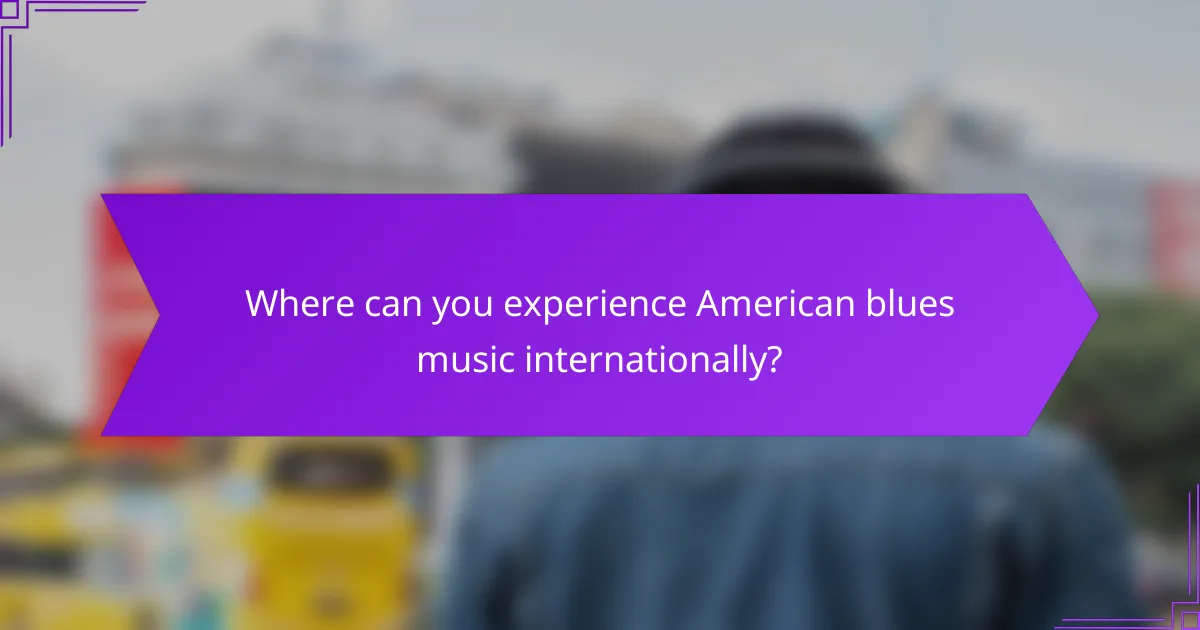
Where can you experience American blues music internationally?
American blues music can be experienced globally through various festivals, clubs, and events that celebrate this influential genre. From Europe to Asia and beyond, blues enthusiasts can find vibrant scenes that showcase both local and international talent.
Blues festivals in Europe
Europe hosts numerous blues festivals that attract artists and fans from around the world. Notable events include the Montreux Jazz Festival in Switzerland and the Notodden Blues Festival in Norway, both of which feature a mix of established and emerging blues musicians.
These festivals often offer workshops, jam sessions, and opportunities to meet artists, making them ideal for fans looking to deepen their appreciation of blues music. Ticket prices can vary, typically ranging from €30 to €150 depending on the festival and lineup.
Blues clubs in Asia
Asia has a growing blues scene, with clubs in cities like Tokyo, Seoul, and Bangkok showcasing local and international blues acts. Venues such as The Blue Note in Tokyo and B.B. King’s Blues Club in Bangkok provide intimate settings for live performances.
Visitors can enjoy a mix of traditional blues and contemporary interpretations, often accompanied by local cuisine. Cover charges usually range from USD 10 to USD 30, depending on the artist and day of the week.
American blues in South America
In South America, American blues music is celebrated through various cultural events and clubs. Cities like Buenos Aires and São Paulo have vibrant blues scenes, with local artists often blending traditional blues with regional styles.
Festivals such as the Buenos Aires Blues Festival attract both local and international talent, providing a platform for blues enthusiasts to experience the genre’s evolution. Entry fees for these events typically range from ARS 500 to ARS 2000.
Blues events in Africa
Africa’s blues scene is rich and diverse, with events that highlight the genre’s roots and its connection to African music. Festivals like the Cape Town International Jazz Festival in South Africa often feature blues artists alongside jazz and other genres.
Local clubs in cities such as Lagos and Nairobi also host regular blues nights, where audiences can enjoy performances that reflect the continent’s unique musical heritage. Ticket prices for these events can vary widely, often ranging from ZAR 100 to ZAR 500.
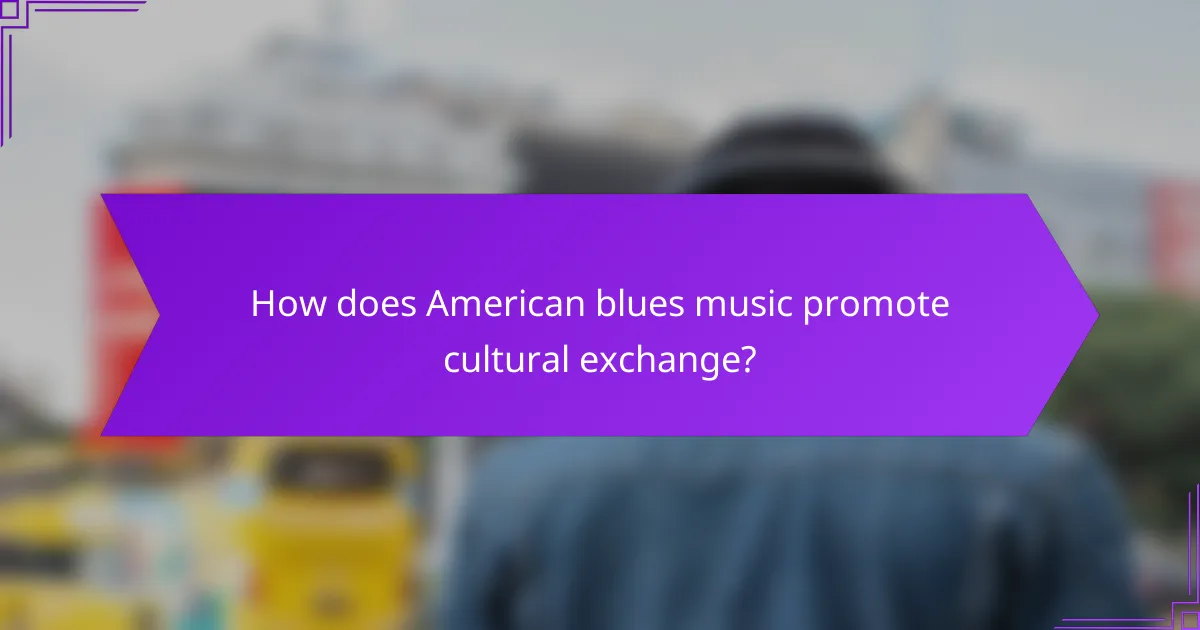
How does American blues music promote cultural exchange?
American blues music fosters cultural exchange by influencing and blending with diverse musical traditions worldwide. This genre serves as a bridge, connecting artists and audiences across different cultures through collaboration, festivals, and educational initiatives.
Collaborations with international artists
Collaborations between American blues musicians and international artists have become increasingly common, creating unique musical fusions. For instance, blues artists from the U.S. often team up with musicians from Africa, Europe, and Asia, resulting in innovative sounds that reflect both cultures.
These partnerships not only enrich the music but also promote understanding and appreciation of different cultural backgrounds. Artists like Keb’ Mo’ and Eric Bibb have worked with musicians from various countries, showcasing how blues can adapt and thrive globally.
Cross-cultural music festivals
Cross-cultural music festivals play a significant role in promoting American blues music around the world. Events such as the Montreux Jazz Festival in Switzerland and the North Sea Jazz Festival in the Netherlands feature blues artists alongside performers from other genres, attracting diverse audiences.
These festivals provide a platform for cultural exchange, where attendees can experience different musical styles while enjoying blues performances. They often include workshops and jam sessions, allowing musicians from various backgrounds to collaborate and learn from each other.
Blues education programs abroad
Blues education programs abroad are essential for spreading knowledge and appreciation of this genre. Many countries have established workshops and courses that teach the history, techniques, and cultural significance of blues music.
For example, programs in Europe and Asia often invite American blues musicians to lead classes, providing firsthand experience and insights. These initiatives not only educate aspiring musicians but also help preserve the heritage of blues music while fostering international connections.

What are the challenges faced by American blues musicians globally?
American blues musicians encounter several challenges worldwide, including market saturation, cultural appropriation, and limited access to resources. These factors can hinder their ability to reach broader audiences and sustain their careers.
Market saturation
Market saturation occurs when there are too many artists competing for the same audience, making it difficult for individual musicians to stand out. In the blues genre, this is particularly evident as both established and emerging artists vie for attention in a crowded landscape.
To navigate market saturation, musicians should focus on developing a unique sound or style that differentiates them from others. Collaborating with artists from different genres or incorporating diverse influences can also help create a distinctive identity.
Additionally, leveraging social media platforms and streaming services can enhance visibility. Engaging with fans through live performances and interactive content is crucial for building a loyal following in a saturated market.
